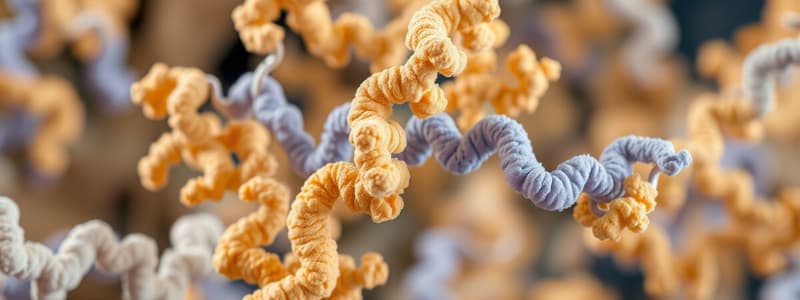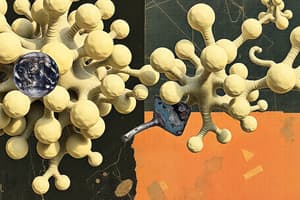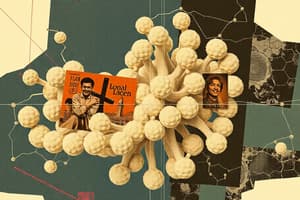Podcast
Questions and Answers
Most of the chemical work of the cell is mediated by which kind of proteins?
Most of the chemical work of the cell is mediated by which kind of proteins?
- Fibrous proteins
- Structural proteins
- Enzymatic proteins
- Globular proteins (correct)
What are globular proteins?
What are globular proteins?
Proteins whose three-dimensional folded shape is relatively compact.
How is the structure of globular proteins different from fibrous proteins?
How is the structure of globular proteins different from fibrous proteins?
Globular proteins have polypeptide chains folded into compact structures, unlike the extended forms of fibrous proteins.
What is a typical example of a fibrous protein?
What is a typical example of a fibrous protein?
What is distinct about the tertiary structure of globular proteins?
What is distinct about the tertiary structure of globular proteins?
What is the major determinant of a globular protein's functional properties?
What is the major determinant of a globular protein's functional properties?
What two methods provide structural information with atomic-level details for proteins?
What two methods provide structural information with atomic-level details for proteins?
Globular proteins possess secondary structures and are also folded into what?
Globular proteins possess secondary structures and are also folded into what?
What is one of the smallest globular proteins?
What is one of the smallest globular proteins?
What does human ubiquitin do?
What does human ubiquitin do?
How do cartoon models represent proteins?
How do cartoon models represent proteins?
What does a cartoon rendering allow easy identification of?
What does a cartoon rendering allow easy identification of?
When is a stick model of a protein useful?
When is a stick model of a protein useful?
In most cases, what is of greatest importance in defining a protein's function?
In most cases, what is of greatest importance in defining a protein's function?
We can think of this surface as the protein's what?
We can think of this surface as the protein's what?
In a typical globular protein, there is no what?
In a typical globular protein, there is no what?
The secondary structures of some proteins are composed almost solely of either what or what?
The secondary structures of some proteins are composed almost solely of either what or what?
The secondary structure of myoglobin is mostly what?
The secondary structure of myoglobin is mostly what?
What is neuraminidase?
What is neuraminidase?
What is the secondary structure of neuraminidase like?
What is the secondary structure of neuraminidase like?
What is triosephosphate isomerase (TIM)?
What is triosephosphate isomerase (TIM)?
What is the secondary structure of TIM like?
What is the secondary structure of TIM like?
What is the first common principle about the classification of globular proteins?
What is the first common principle about the classification of globular proteins?
What is the second common principle about the classification of globular proteins?
What is the second common principle about the classification of globular proteins?
What is a domain?
What is a domain?
Domains are interconnected by what?
Domains are interconnected by what?
Multiple domains are especially common in what?
Multiple domains are especially common in what?
Relatively small proteins like ubiquitin tend to have what kind of domains?
Relatively small proteins like ubiquitin tend to have what kind of domains?
Different domains often perform differing what?
Different domains often perform differing what?
A given domain type may be found where?
A given domain type may be found where?
What is the 3rd common principle about the classification of globular proteins?
What is the 3rd common principle about the classification of globular proteins?
What is an example of a type of supersecondary structure found in globular proteins?
What is an example of a type of supersecondary structure found in globular proteins?
What is a good example of a globular protein that has supersecondary structures?
What is a good example of a globular protein that has supersecondary structures?
What is the most common type of domain fold found in proteins?
What is the most common type of domain fold found in proteins?
What is the β-barrel?
What is the β-barrel?
What are the four basic folding patterns found in globular proteins?
What are the four basic folding patterns found in globular proteins?
What is topology as it refers to protein classification?
What is topology as it refers to protein classification?
What is a Rossman fold?
What is a Rossman fold?
There are 130 distinct homologous superfamilies of proteins that include a Rossman fold topology. What are they?
There are 130 distinct homologous superfamilies of proteins that include a Rossman fold topology. What are they?
How do homologous superfamilies work?
How do homologous superfamilies work?
The majority of globular protein structures can be broadly classified as 'mainly α,' 'mainly β,' and 'α + β.' A small number of globular proteins has little what?
The majority of globular protein structures can be broadly classified as 'mainly α,' 'mainly β,' and 'α + β.' A small number of globular proteins has little what?
List the 4 things on our growing list of common principles of globular protein structure.
List the 4 things on our growing list of common principles of globular protein structure.
If we examine the amino acid sequences of globular proteins, we find no particular distribution pattern of what?
If we examine the amino acid sequences of globular proteins, we find no particular distribution pattern of what?
But when we look at the positions of the amino acids in the three-dimensional structure of globular proteins, we invariably find what?
But when we look at the positions of the amino acids in the three-dimensional structure of globular proteins, we invariably find what?
What is one kind of a compact turn for a polypeptide chain to go from one β segment or α helix to the next?
What is one kind of a compact turn for a polypeptide chain to go from one β segment or α helix to the next?
There are several varieties of β turn, each able to accomplish what?
There are several varieties of β turn, each able to accomplish what?
Bends and turns most often occur where in globular proteins?
Bends and turns most often occur where in globular proteins?
Not all parts of globular proteins can be conveniently classified as what?
Not all parts of globular proteins can be conveniently classified as what?
What have some of the weird contorted loops and folds in the polypeptide chains of globular proteins been called?
What have some of the weird contorted loops and folds in the polypeptide chains of globular proteins been called?
Flashcards are hidden until you start studying
Study Notes
Overview of Globular Proteins
- Globular proteins mediate various cellular functions, including synthesizing, transporting, and metabolizing.
- Their three-dimensional folded shape is compact, unlike the extended forms of fibrous proteins.
Structural Characteristics
- The polypeptide chains of globular proteins fold into compact structures, contrasting with the filamentous structures of fibrous proteins, exemplified by myoglobin (compact) vs. collagen (extended).
- Tertiary structure is crucial as it determines a globular protein's functional properties, achieved through the folding of secondary structural elements (α helices and β sheets).
Protein Examples and Functions
- Human ubiquitin, containing 76 amino acids, plays a vital role in targeting proteins for degradation.
- Myoglobin has a secondary structure predominantly composed of α helices.
- Neuraminidase, important for viral pathogenesis, mainly consists of β sheets.
- Triosephosphate isomerase (TIM), involved in glucose utilization, has both α and β structures.
Domains and Classification Principles
- Classification of globular proteins can be based on dominant secondary structural motifs, with many proteins comprising multiple domains.
- A domain is a compact, locally folded region of tertiary structure, often consisting of 150-250 amino acids, recognizable within the protein.
- Proteins with multiple domains are common, while smaller proteins like ubiquitin typically consist of a single folded domain.
- Different domains may have unique functions and may recur across various proteins, like ATP-binding domains.
Supersecondary Structures and Folds
- Domains can feature repeating secondary structural motifs known as supersecondary structures, such as β/α motifs.
- TIM exemplifies a protein with supersecondary structures, possessing a β-barrel configuration, which is a prevalent domain fold in proteins.
Folding Patterns and Topology
- Four basic folding patterns of globular proteins include packing around α helices, frameworks of β sheets, combinations of both, or minimal structures.
- Topology refers to the specific order of the secondary structural elements in a protein chain, influencing classification.
Homologous Superfamilies
- The Rossman fold is a domain structure found in enzymes interacting with NAD, critical for ATP production.
- A total of 130 distinct homologous superfamilies exhibit this topology, indicating a shared evolutionary ancestor.
General Principles of Globular Protein Structure
- Globular proteins possess defined interiors and surfaces, with twisted sheets often arranged in barrel structures.
- Polypeptide chains can create turns and corners for structural transition.
- Tertiary structures typically localize hydrophobic residues in the interior and hydrophilic residues on the surface.
Turns and Irregular Structures
- Compact turns like β turns enable polypeptide chains to reverse direction efficiently.
- Not all regions of globular proteins fit neatly into classifications of helix, β sheet, or turns; some exhibit contorted loops known as "random coil," though this term misrepresents their structure, which can be well-defined.
Additional Notes
- Structural variations can often be seen at the protein surface, with bends and turns enhancing function and stability.
Studying That Suits You
Use AI to generate personalized quizzes and flashcards to suit your learning preferences.





